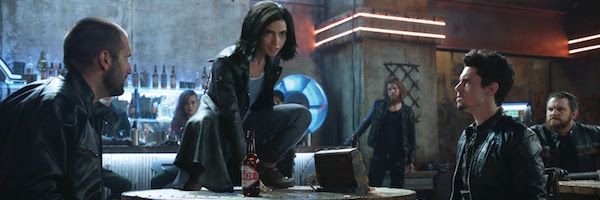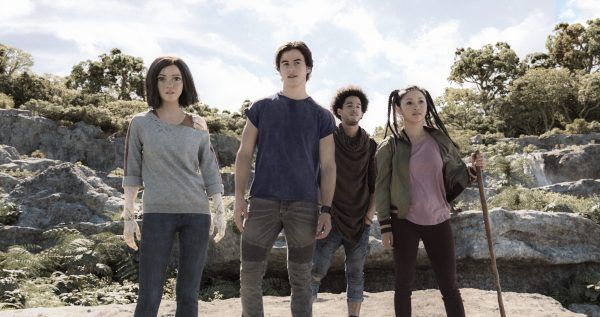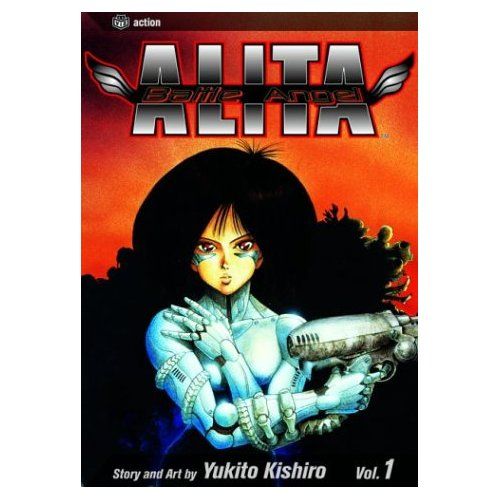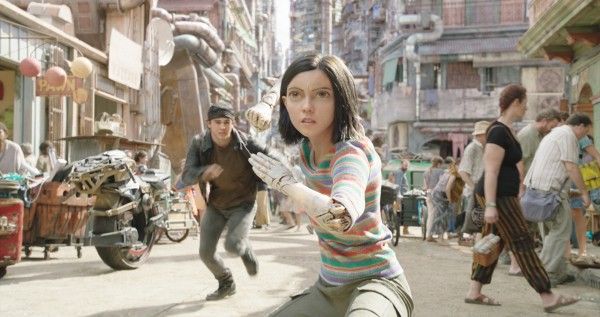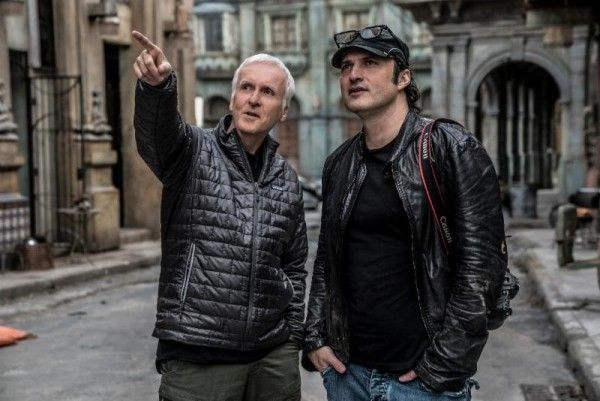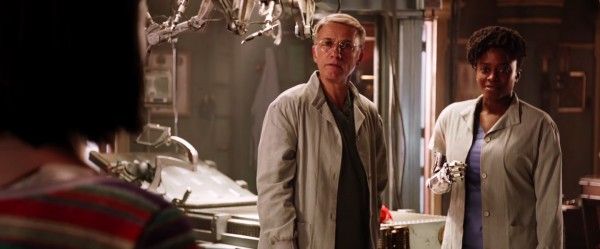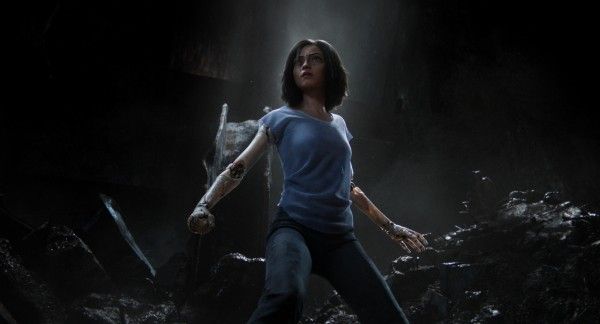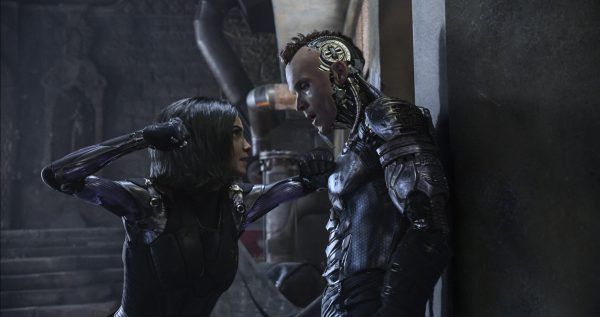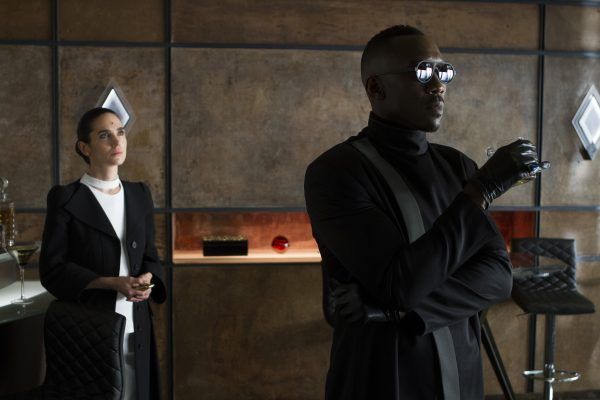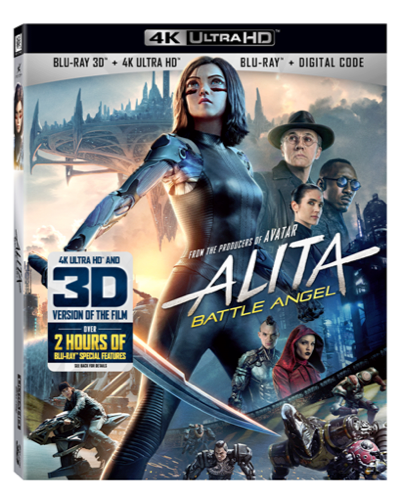Academy Award-winners James Cameron and Jon Landau, and visionary filmmaker Robert Rodriguez, brought Alita: Battle Angel to life for audiences around the world. Now, the epic adventure is available on home video release, complete with hours of extensive special features that go behind-the-scenes to show off the journey from manga to the screen, along with what it took to bring Alita to life. Plus, fans can go deeper into the universe of Alita: Battle Angel to learn about the past, the characters of the present, and the thrilling sport of Motorball.
If you're unfamiliar with the story, either from the manga, the anime, or the live-action film, Alita (Rosa Salazar) awakens with no memory of who she is in a future world she does not recognize. She is taken in by Ido (Christoph Waltz), a compassionate doctor who realizes that somewhere in this discarded cyborg shell is the heart and soul of a young woman with an extraordinary past. When deadly and corrupt forces come after Alita, she discovers a clue to her past - she has unique fighting abilities that those in power will stop at nothing to control. If she can stay out of their grasp, she could be the key to saving her friends, her family and the world she's grown to love. The action-packed film, also starring Jennifer Connelly, Mahershala Ali, Ed Skrein, Jackie Earle Haley, and Keean Johnson, is available on Digital, Blu-ray, and DVD now. Check out our Special Features review below!
Alita: Battle Angel Blu-ray Special Features
-
Alita’s World - Get a deeper look into the world of Alita: Battle Angel with these dynamic motion comics.
- The Fall - A look back at the terrible war that almost destroyed two planets and set the stage for the cyborg warrior Alita’s return 300 years later. This 5-minute high-quality motion-comic gives you the historical background that the movie itself barely even touches on. This also introduces Alita, known as Yoko, from her birth and into her teenage years as a "high value military asset." It also tells of a bioweapon designed by Mars to attack Earth, a virus that devastates the population save for the sealed sky city of Zolom. Earth's counterstrike of a nanobot plague wiped out the Martian forces. All of this led to Zolom as the last surviving bastion of humanity where most lived in Iron City, literally under the cruel leadership of those in Zolom above.
- Iron City - Hugo gives a guided tour of the Iron City he knows, showing off its dark corners and broken-down neighborhoods. He introduces us to the world of Barrio Purgatorio, the Factory District, Barrio Viego, Barrio Oscuro, Corazo D'Acero or Heart of Steel, Barrio Latino, Barrio Asiatico (Chinatown), Medina (the Islamic section with an African street market), and the Motoball Arena. Blue-collar workers with bootleg cybernetic parts and people from all over the world live side by side with street gangs and other human refuse.
- What it Means to Be a Cyborg - Hunter-warrior Zapan tracks his mark across Iron City while musing about what it means to be a cyborg. This is a great little motion comic that acts like an introspective from Zapan, courtesy of Ed Skrein. He breaks down the pros and cons of being a cyborg as it compares to the human condition, all while gleefully hunting down his bounty marks.
- Rules of the Game - A high-octane “crash course” in Motorball, introducing the rules, game-play, and the top-ranked players and their arsenal of weapons. This motion-comic feels a little less polished than the others, though it's always a blast to learn more about this bonkers sport that's sure to be an Olympic event in the near future.
-
From Manga to Screen – (30 minutes) A behind-the-scenes look into the origins of Yukito Kishiro’s beloved manga, “Gunnm,” and the long road to bring it to life on the big screen. Producer Jon Landau, director Robert Rodriguez, screenwriter/producer James Cameron, and star Rosa Salazar revisit the source material for the story, complete with he original manga illustrations. Yukito himself walks through the history of manga in Japan and his childhood with formative manga stories; this is the real sell of the featurette here. Yukito says that focusing on sci-fi and fantasy was extremely difficult early in his career, but her persevered. Gally, Alita's name in the manga, was originally a secondary character, but his Yukito's publisher suggested that he do a solo story with her. He received no fan mail for it and the story came in third in a poll among their readers. But once the story hit Business Jump in 1995, all of that changed and the fans let their love for the character be known. Cameron reveals that it was Guillermo del Toro who turned him on to the story, leading to Cameron picking up the rights to it. Cameron took a trip to meet Yukito face to face in order to make a commitment to him to honor the source material. Cameron's 185-page script had a Romeo and Juliet love story to it, but it took him over 5 years to get to a point where he was happy with it. They opted to wait until the technology evolved to the point of being able to bring Battle Angel to life; Avatar came first in order to develop the motion-capture/performance technology. (Ironically, producing Alita helped to improv the tech for the Avatar sequels.) Concept design supervisor Dylan Cole, Production Designers Caylah Eddlebr and Steve Joyner, and Avatar franchise art director/concept design director Ben Procter lend their expertise to the discussion of the movie's concept art and bringing that all to life.
-
Evolution of Alita - (20 minutes) How Alita was brought to life, from the casting of Rosa Salazar, to performance capture, and final VFX by WETA Digital. Go behind the scenes to see Salazar's original audition and screen tests to play Alita, something that Landau says was more important to getting the movie made than the filmmaking technology itself. Salazar also went from being "made out of croissants" into a tough training routine in the months ahead of production. She also reveals that there was a team of 9 women who helped to bring Alita to life through their physical performance and various talents. You even get to go into detail on all three Alita's body types: the decorative and ornate doll body; the militarized battle suit designed by U.R.M, the United Republic of Mars; and the #99 Motorball suit, representing her past as Soldier 99. Weta also gets in on the fun here, talking about their performance-capture technology and talking points like the fact that Alita's eyeball has "more geometry than all of Gollum in Lord of the Rings." Richard Baneham, the Oscar-winning visual effects supervisor, leads the effects team in walking viewers through an extensive behind-the-scenes tour of bringing Alita to life. And yes, they do address Alita's big eyes, which are an important part of her character but were also finely tuned throughout the production process. They focus on the idea of bringing Salazar's impressive performance to the screen through photoreal visualizations, and it's a very convincing argument.
- Motorball - (6 minutes) Go inside Iron City’s favorite pastime, from the origins and evolution of the sport, to rules on how the game is played. Once you know that this game in this world is bigger than soccer in our world, it puts it into a new perspective. The creation and design of the Motorball arena was inspired by video of people skateboarding through an abandoned waterpark, including the tubes and slides, giving it a more intimate and interactive feel than a NASCAR track. There's a great breakdown of the Champions League members and their specialties, along with the racers in the Cutthroat Challenge.
-
James Cameron, Robert Rodriguez and cast Q&A moderated by Jon Landau (27 minutes) - The cast and crew answer fan questions about what makes Alita's story so compelling and accessible worldwide, Salazar's training for the Panzer Kunst fighting style,
- Robert Rodriguez’s 10-Minute Cooking School: Chocolate - (6 minutes) A cooking lesson on how to make delicious chocolate like that seen in the movie. Rodriguez made a custom mold for the chocolate with the symbol of Zolom using a 3D printer. This is delightful and now I want to go make chocolate for a living.
- 2005 Art Compilation (2019) - (14 minutes) James Cameron’s original compilation of concept art for the then-titled Battle Angel: Alita, presented with new voiceover and music. This plays like a well-produced animatic for the movie and I would have been sold on this were I a producer hoping to greenlight it.
-
Scene Deconstruction - View three different stages of the production - the original live action performance capture, the animation stage, and the final Weta VFX from four different scenes. This may be the first time a special feature has gone into this level of detail for the filmmaking process as you essentially get to see what Rodriguez and the Weta VFX team saw, for these specific scenes:
- I Don’t Even Know My Own Name - Ido introduces Alita to oranges.
- Just an Insignificant Girl - Alita and Hugo climb atop a high tower to take in the view.
- I’m a Warrior Aren’t I? - Alita challenges Ido about her true identity and abilities.
- Kansas Bar - It's amazing to watch the Hunter-warriors walking around in their performance-capture suits, and it's also nice to see a real pupper in place of the cyborg dogs. Stick around because this one includes a tease of the epic fight scene.
Alita: Battle Angel Digital Special Features
- Musical Themes - (6 minutes) Composer Tom Holkenborg (aka Junkie XL) offers an in-depth examination of the key musical themes of his Alita: Battle Angel score. Rodriguez and Landau talk about Holkenborg rising to the challenge they set out for him, to make this the most emotional score he's ever done. Holkenborg himself talks about finding the heart and soul of the film for his process. Alita has two themes: One, which is gentle and slow, is heard upon her waking up, like a child's music box; the theme gets more heroic once Alita gets her Berserker body, which grows in size and scope by the end of the movie. Ido's theme is "lowly" and it's the first one you'll hear when he's walking through the scrapyard; written for a trumpet, it was performed on a solo horn instead to give it a more mournful quality. Grewishka's theme starts off "extremely dark" with all the low brass instruments employed, though it does have an "emotional quality" to it for his final scene. The Motorball theme emphasizes the excitement and intensity of the game itself.
-
Streets of Iron City - (17 minutes) Director Robert Rodriguez gives a set tour of Iron City, with cast and crew insights, and a behind-the-scenes look at the city’s creation.
- Iron City - Rodriguez talks about the location shifting to somewhere near the equator since it was meant to have a space elevator hundreds of years ago; that gave it the "Panama City, Old Havana-type look." He wanted to give viewers a dystopian city with a South American feel. The practical set was built on the vacant parking lot behind Rodriguez's Troublemaker Studios, allowing for 97,000 square feet of Iron City. Some 200 craftspeople built the set in 40-50 days.
- Scrapyard - The former site of the space elevator's anchor is now Zolom's garbage dump. Much of the look of it came directly from the manga.
- Ido’s Clinic - The former tuner for Motorball players is now a cybersurgeon who does pro bono repairs for working cyborgs. The space is repurposed from something like a former bank or hotel lobby, converting all of Ido's living space into one shared room.
-
Cathedral - The Cathedral itself was set in Iron City but raised up a bit so you could see it amongst the buildings. It was inspired by cathedrals you might find in Spain or Colombia, just with centuries of decay. This was also built on Troublemaker Studios' lot.
- Ambush Alley - This is the area that Alita spies Ido's nighttime battle and it's the first big action sequence for the film. It's also the first time the production shifted into night shoots.
- Vector’s Office and the Factory - The stark contrast of the Factory to the Scrapyard and Iron City is intended as the one link to Zolom, and to Vector's Office above it. Built almost entirely of glass, Vector is the "top dog" in Iron City and looks out over all of it.
- Kansas Bar - The big bar fight amongst the Hunter-Warriors was inspired by Cameron and Rodriguez's own bar fights from their filmography, which they wanted to top. As he says, the fight is really about "who walks into the bar and who they're fighting." It's "smoky, mysterious, with crazy lighting" but it also has to be destructible and give a sense of presence for the introduction of some unique characters. The bar itself was pulled from Rodriguez's set from the From Dusk til Dawn TV series, with some redesigns. Kansas Bar was named after the band by manga creator Yukito Kishiro.
-
Allies and Adversaries - Meet the allies and adversaries that Alita encounters in Iron City.
- Zapan (4 minutes) A vicious Hunter-Warrior whose physical presence is outmatched only by his vanity. Landau, Rodriguez, Salazar, and actor Ed Skrein talk about bringing this character to life. You also get a great look at the Damascus Blade, including the metal hero blade crafted for the production; Rodriguez gifted it to him on wrap. Other than his face, Zapan is all cyborg, and all digital; lots of time was spent making sure all the parts worked well together.
- Dyson Ido - (4 minutes) Salazar recalls tearing up upon reading about Ido's character arc in the script. The introduction of Ido's late daughter, named Alita, was an original idea from Cameron that wasn't in the original story. Landau reveals that Christoph Waltz didn't see the real entrypoint for Ido's character until he talked to Cameron, who painted it as a father-daughter tale.
- Grewishka (4 minutes) Jackie Earle Haley gives some background on Grewishka and his many emotional beats throughout the story. This is the only character who's cyber-core gets to wiggle and waggle around a bit when he's getting upgrades. He's also a mash-up of the manga characters Makaku and Kinuba. Earle Haley brought a performance that outsized his stature and "filled the room" according to Rodriguez and Landau.
- Nyssiana - (2 minutes) This character, played by Eiza Gonzalez, is one of Grewishka's crew who's revealed as an "insectoid praying mantis nightmare of blades" early on. Her design is actually comprised of real motorcycle parts that they researched to give it authenticity.
- Romo (2 minutes) Another character in this fight, played by Derek Mears, only appears in "about six shots before getting beat up", but he's still got style. Mears calls him "a cybernetic Mr. Potato Head" due to all of the many weapons he has.
-
McTeague (2 minutes) The "bounty hunter / Western cowboy" with his cybernetic "hellhound" dogs was played by Jeff Fahey. They filmed with two real Dobermans and then swapped in stuffed dogs for the CG Hellhounds. Fahey just got to sit back and watch the stunt performers carrying out the bar fight.
- Vector (3 minutes) Played by Mahershala Ali, Vector runs the Factory, controls the sport of Motorball (and its underground gambling ring), and employs hoods to attack people and scrap them for spare parts. He has connections to everyone in the story and often promises to send people up to Zolom.
- Chiren (3 minutes) - Jennifer Connelly's character is described as "bitter" with "all of her hopes centered on getting back to Zolom." She was formerly married to Ido but now partners with Vector to achieve her ends. But her character isn't a one-note villain; her memories as a mother give her a chance at redemption.
- Hugo (3 minutes) Keean Thompson is one of the muggers, along with Tanji (Jorge Lendeborg Jr.), who steal cyborg parts from living people. He wants to stay totally human in order to be able to fit in once he makes his way to Zolom, but meeting Alita changes lots of his misconceptions.
- 2016 Art Reel - (12 minutes) Lightstorm Entertainment and Robert Rodriguez’s 2016 compilation of concept art reflecting the design of the final film. No narration this time, but you get to see how the idea for the film has evolved since the 2005 version. It's a wonderful journey that takes you from beginning to end in a different way.
- Theatrical Trailers
- Alita - Official Trailer
- Alita - Battle Ready Trailer

